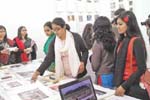 Kibria Print Fair, being held at Dhaka Art Center, covers major and emerging artists, including Wakilur Rahman, Shishir Bhattacharjee, Abul Barq Alvi, Laila Sharmeen, Nisar Hussain etc.
Kibria Print Fair, being held at Dhaka Art Center, covers major and emerging artists, including Wakilur Rahman, Shishir Bhattacharjee, Abul Barq Alvi, Laila Sharmeen, Nisar Hussain etc.
The event marks 84th birth anniversary of artist Mohammad Kibria and 3rd anniversary of Dhaka Art Center. The participating institutions are: Printmaking Department, Faculty of Fine Arts (FFA), University of Dhaka; Printmaking Department, Institute of Fine Arts, Chittagong University; Printmaking Group, Fine Arts Department, Rajshahi University; Printmaking Studio, Fine Arts Department, University of Development Alternative (UODA); Atelier ’71; Cosmos Atelier ’71; Shunno Art Space, Dhaka; Bornika Print Studio, Dhaka; Bangladesh Printmakers Association; Porapara Space for Artists, Chittagong; and Kibria Printmaking Studio, Dhaka Art Centre.
Renowned Japanese ceramist Professor Koichi Takita inaugurated the festival on January 1. Abul Barq Alvi, dean of Faculty of Fine Arts, Dhaka University was present as special guest on the occasion and Rafiqun Nabi presided over the inaugural session.
The collection contains Shishir Bhattacharjee’s print that shows a monster — its teeth and eyes looking menacing. It has a brown background and a face of a human being.
Wakilur Raman is more post-modern than most other printmakers. The two pieces by him have lines and smudges of pleasant colours like rose, purple brown, and grey that appeal to the average sensibility. There are bars of black, trees, birds and animals — all merged into one.
Bulbon Osman, known for teaching art history, has his delineation of an ancient, enormous parrot — with houses, trees and birds in the backdrop.
Next to it is K.G. Subramanian’s entrée with a bird, who is making a face with its claws and sharp beaks.
Rafiqun Nabi’s subject of portrait is seemingly disgusted with the turn of modern life.
Laila Shermeen’s work remains delicate, with tiny tree, birds and boats. Her enchanting soft colours are yellow, green and beige. In contrast is Raziuddin Chowdhury’s depiction of clothes with strokes and lines of grey.
Ruksmini, coming from Seattle, US, shows vivacity in urban setting. Even the trees and leaves have expressions. Rajuddin Chowdhury brought in interlacing leaves forming semi-circle, with more plants at the bottom. Onukul Majumder’s work depicts fascinating curves in a rounded motif. His creation is modern with the village woman’s head covered, her eyes very clear.
Rashid Amin’s work has layers of white lines on deep, sea green. It has its appeal because of its simplicity. Tawfiqur Rahman’s creation has a hungry dog with dots on its body. Tawfique is well known for his sculpture. Queenie’s work has boats, river waves, trees, birds, and people merged into one whole.
Nagarbashi Barman has depicted fish bones and boats with waves curling at the back and front. He also did a presentation of a human soul caught in the web of life.
Works by Dhali Al Mamun and AH Dhali Tomal are also on display. The one with goats drinking water by Tomal surely made heads turn with its depiction of reality and sensitivity found among animals. Sylvia Nazneen has done figures that are intertwining in water.
Monica Bose, who lives in the US, has depicted female figure developed from an onion.
Farzana Rahman’s “Cityscape” is a combination of paper transfer and dry point. One sees the buildings of a city and the lights. Bipasha Hayat has attempted to do a portrait of Rabindranath with his flowing beard and cloak.
Shishir Bhattacharjee and Kuhu Plamondon have had a go at Tagore’s portraits too. The well-known sculptor and painter Hamiduzzaman also did a sketch of the bard.
Ronnie Ahmed with his snake carrying a candle on his head is surely different, along with the duck and the human figures.
Prints are one way to make art popular among the masses. At Dhaka Art Center are works from groups all over Bangladesh, where printing machines have been set up, and artwork has burgeoned.
-With The Daily Star input




















